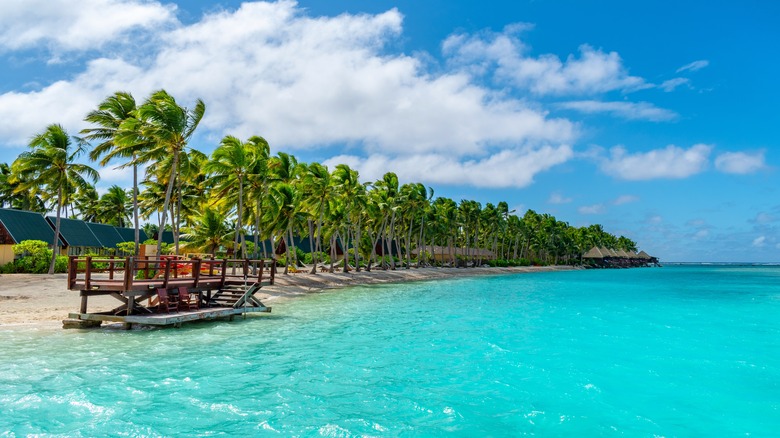Aitutaki
The color of the water in the lagoon of this Cook Island haven almost defies belief, such as clarity and ice-blue hue (luckily, the temperatures are far from cold). This is a small island with less than 2,000 residents, reached by plane from Rarotonga (the largest of the Cook Islands), a flight that takes less than an hour. The destination comprises the main island and smaller “motu” (or islets) set within the lagoon, and it certainly is a tropical paradise — one that consistently pulls in honeymooners.
Life here is steeped in languor, but in a good way, with quiet days on sun-kissed beaches and heavenly dips in the clear lagoon. Visitors can also explore the water aboard a kayak, take a boat tour to one of the motus, or don a mask and fins and spot turtles and vibrant reefs during a snorkeling excursion. For those who like their activities a little less sedate, kiteboarding lessons are on offer.
Atiu
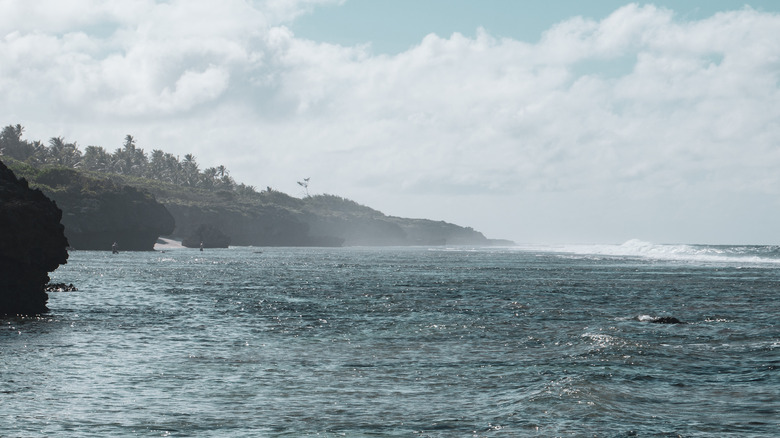
Another place in the Cook Islands, this isle is a smart choice for fans of nature, with some excellent birdwatching, and can be reached by plane from Rarotonga in about 40 minutes. The population here is paltry, with about 400 inhabitants, lending the island an unspoiled atmosphere. The lack of built-up areas makes it a tranquil getaway, and travelers looking for buzzing social life and wild bars will be sorely disappointed. More attractive is the sober representation of island life, visible in the five villages that dot the island. Atiu is a fertile dot, and among the crops that flourish here is coffee — for lovers of a cup of Joe, this place is paradise.
It’s also a fun place for unexpected exploration, with many caves tucked around Atiu. The Anatakitaki Cave is among the most famous, not only for its wild, ghoulish interiors but also because it is home to the Kopeka, a small bird native to the Cook Islands that lives exclusively in limestone caverns. Other birds ornithologists can look for include the Great Frigate and the endangered Kakerori.
Big Island
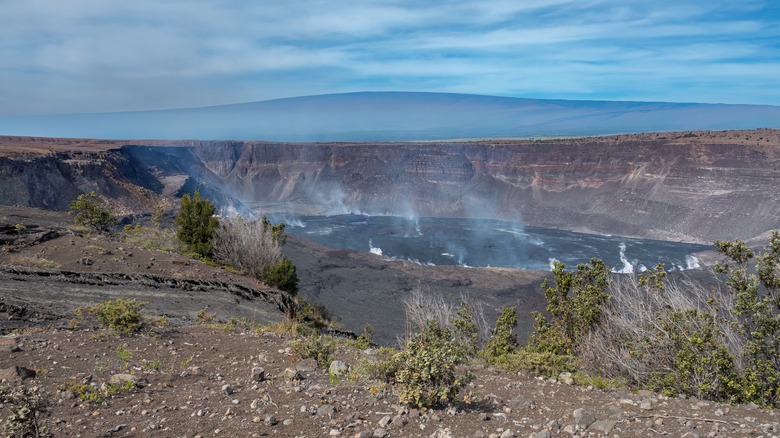
LouieLea/Shutterstock
Officially known as the island of Hawaii but commonly referred to as the Big Island, this is the largest in the chain of islands that make up America’s 50th state. It is substantially bigger than the other islands of Hawaii, and such is its geographic variety that it is home to many different climates. Visitors can find sections that fall under Wet Tropical and those categorized as Polar Tundra, all forged by the effects of the large volcanoes found here.
Travelers can wander around achingly gorgeous valleys or laze on a black-sand beach, and activities abound on the Big Island. One site not to miss is Hawaii Volcanoes National Park, a destination of epic proportions and a Unesco World Heritage site. It rises all the way from sea level up to almost 14,000 feet and features the huge domes of Kilauea and Mauna Loa. Beyond the sheer power and grandness of the volcanoes and the landscape that they produce, the park contains attractive areas with huge ferns.
Bora Bora
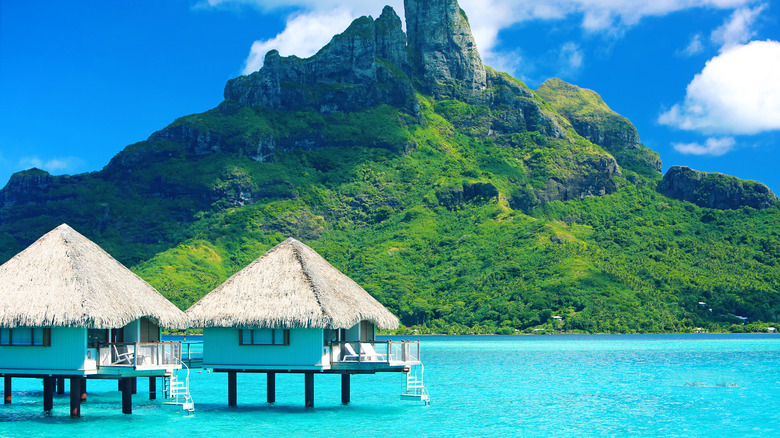
Triggerphoto/Getty Images
The name of this French Polynesian island, for many, embodies the quintessential luxury tropical paradise. Perhaps it’s the softness of the name, Bora Bora, or how it rolls off the tongue, almost like a whisper, but this island handsomely lives up to its image. In part, that’s helped by the spate of luxe resorts that travelers will find here, many providing that deliciously desirable accommodation of the overwater bungalow. Among the top-shelf brands with properties here are Conrad, St. Regis, InterContinental, Four Seasons, and Pearl Resorts, the kinds of dream destinations that are bucket-list picks.
Away from the rooms, guests can lounge on perfect white-sand beaches, float in the clear waters of a calm lagoon, and peer, in awe, at the peak of Mount Otemanu. The choices for disciples of water sports are dizzying, with snorkeling, diving, kayaking, paddle boarding, and yachting, all of which will bring travelers close to sharks, manta rays, and scores of other marine life.
Fakarava
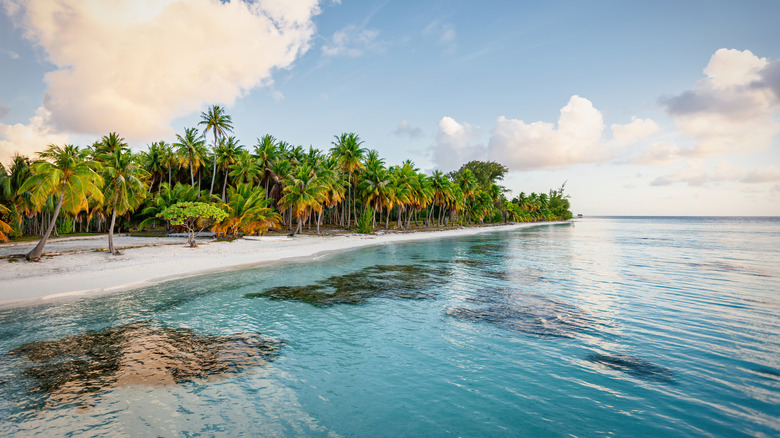
Mlenny/Getty Images
French Polynesia encompasses many islands within the greater region of Polynesia, and not just the household names of Bora Bora and Tahiti. This island, which is part of a UNESCO Biosphere Reserve, is a realm of varying landscapes and environments that sits about 250 miles from Tahiti. The appeal is on land and below the water, where healthy reefs welcome turtles, barracudas, dolphins, and shivers of gray sharks.
Back on terra firm, Fakarava supplies visitors with sumptuous beaches, some with pink sand and shells that local artisans might sweep up and transform into items of jewelry. There are pearl farms on the island, a big money earner for the local economy, and an intriguing place to visit. Trips around the biosphere can be conducted on foot, aboard a kayak, or even on a bicycle, and travelers will see oceans, lagoons, coconut plantations, beaches, and forested interiors.
Great Barrier Island
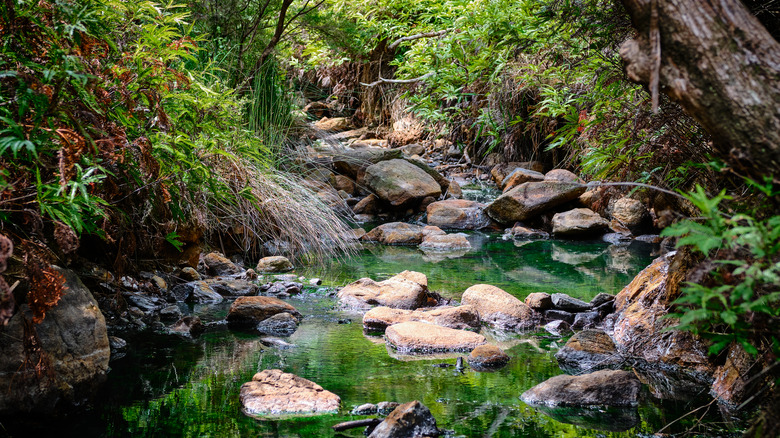
inProgressImaging/Shutterstock
For a sense of what a green, environmentally conscious Polynesian island looks like, visitors should stop by this spot in New Zealand, accessible by ferry or flight from Auckland. Part of the Hauraki Gulf Islands, a natural archipelago that protects the country’s largest city from the rolling Pacific, Great Barrier Island runs entirely on solar power and uses freshwater as its water source. Only about 1,000 people live on the island year-round, a tight-knit community used to welcoming visitors to these rugged shores.
Upon exploring, travelers will notice a contrast on either side of the island, with tall cliffs and pounding surf on the east, where the island confronts the ocean, while the western side is more serene, with tranquil bays and harbors. More than half of the land falls under the control of the government, and it has been left refreshingly wild, with indigenous plants, forests, and even hot springs. By day, the hiking is phenomenal, while at night, the stargazing is unrivaled.
Kauai
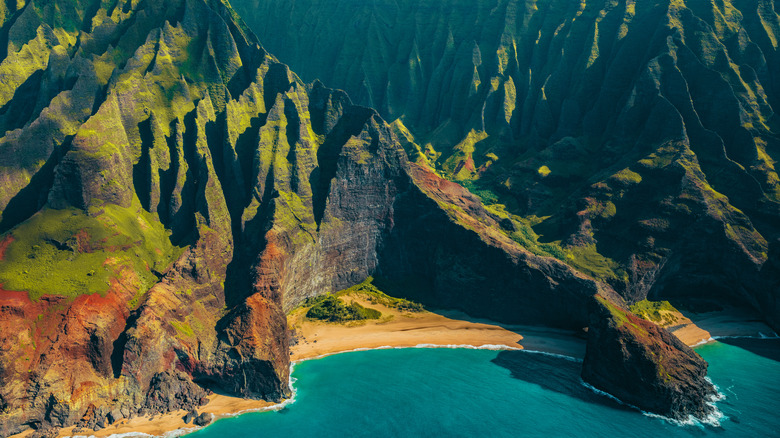
Maridav/Shutterstock
Hawaii’s self-proclaimed “Garden Island,” Kauai, is a godsend for adventurers. The lay of the land here feels almost prehistoric, as though it has been untouched for millennia, with valleys covered in trees and plants, craggy mountainous slopes that look both daunting and inviting, cliffs that rise vertiginously above the ocean, and deep, dense rainforests. So much of the island can’t be reached by car, which has helped it maintain an uncommercial, natural ambiance.
It’s also allowed the island’s nature to shine. While some of the most fun activities are rooted in human invention — zip lining, kayaking along rivers or the ocean, snorkeling near the coastline, tearing around the backcountry on an ATV — much of the fun can be exhilaratingly low-impact. Koke’e State Park sits 4,000 feet above sea level and commands great views of valleys and canyons, evident from the many hiking trails here. And Kauai’s beaches, of course, are sublime.
Maui
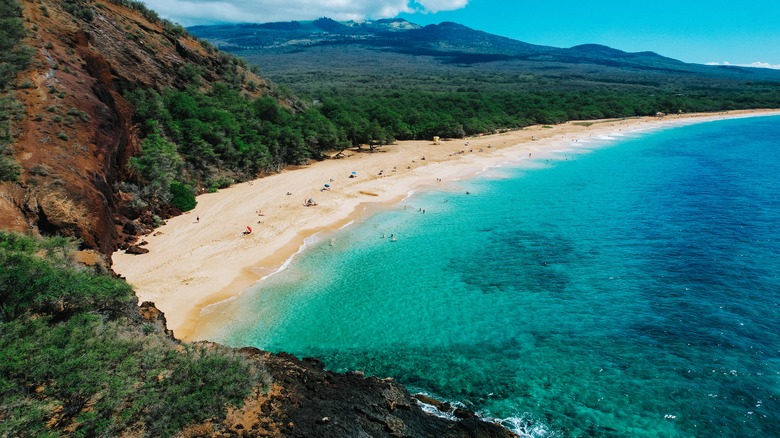
Aspects and Angles/Shutterstock
Despite a devastating fire in and around Lahaina in early August 2023 that ravaged large parts of Maui, this island in Hawaii is slowly welcoming back tourists, a group of visitors that plays a key role in the state’s economy. The island’s natural allure is similar to other Hawaiian islands, with land that dramatically rises and falls, while clear turquoise water that quickly transforms to dark, deep blue kisses the island’s fringes.
The snorkeling here is sensational, and Honolua Bay is one of Maui’s stand-out spots. At this large inlet, the reef sits a little further out in the bay, and while getting there requires some exertion, it is definitely worth it. Maui also promises good water sports, excellent hiking, and even whale watching. Still, it’s also a strong center for artistic tradition, especially at the Maui Arts & Cultural Center, where music and dance performances often involve local artists.
Moorea
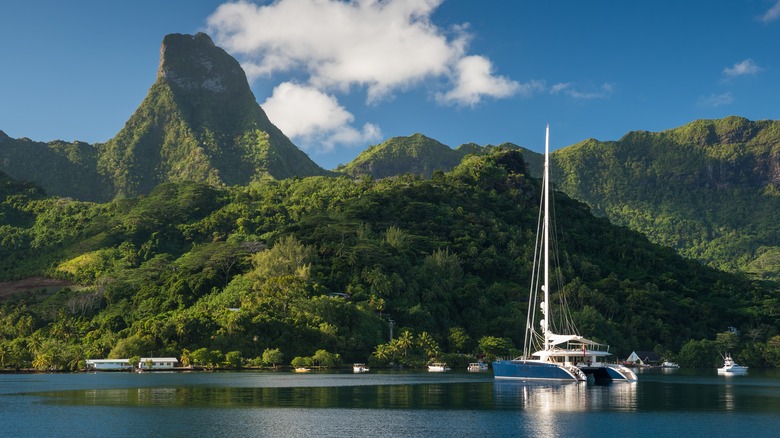
Lucia.Pinto/Shutterstock
The scenery and snorkeling are out of this world on this island in French Polynesia. An obvious place to start is the water, with divine beaches all around the island. One doesn’t have to travel far to get to some transcendental sand — one of the finest is Tamae Beach, a grand sweep close to the airport. Other beautiful spots include Ta’ahiamanu Beach, which has healthy coral just offshore, and Tipanier Beach, where rays and sharks frequent a nearby sandbar.
The snorkeling in the island’s lagoon is, unsurprisingly, awe-inspiring, and with reefs all around the island, marine life is never far from sight. The landscape is equally enticing, and there are eight peaks on Moorea, each graced by hiking routes that allow visitors to immerse themselves in the fecund beauty. One of the most memorable vistas is from the Belvedere viewpoint, which looks over a deep, verdant valley.
Niue
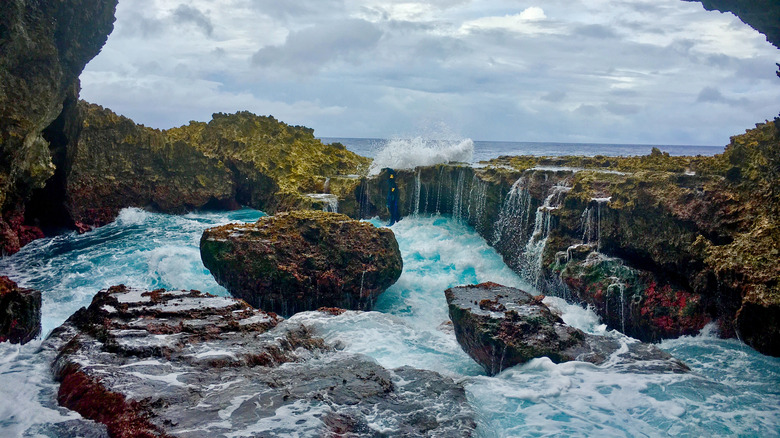
Maximilien Leblanc /Getty Images
This small country — about 100 square miles, or about the size of Lincoln, Nebraska — has some truly dramatic limestone formations. Visitors will quickly feel a sense of community here, helped by a Lilliputian population that mirrors that island’s proportions, with only about 1,500 locals living on Niue (pronounced “nyoo-ay”). Time here will be remembered for the simplicity of the experience.
Travelers can laze on beaches, grab a mask and snorkel, marvel over the aquatic treasures underwater, and hop on a boat for a morning of sport fishing. At night, the skies reveal infinite stars and constellations, and since there is little light pollution in Niue, stargazing is a revelation. Perhaps what is most enduring about a trip here is the chance to explore caves and other limestone grottos, some of which sit close to the water. At Limu, where fresh and seawater merge, there are spots to swim and places to explore the caves, while at Matapa Chasm, adventurers can wade in water in the shadow of towering cliffs.
Nuku Hiva
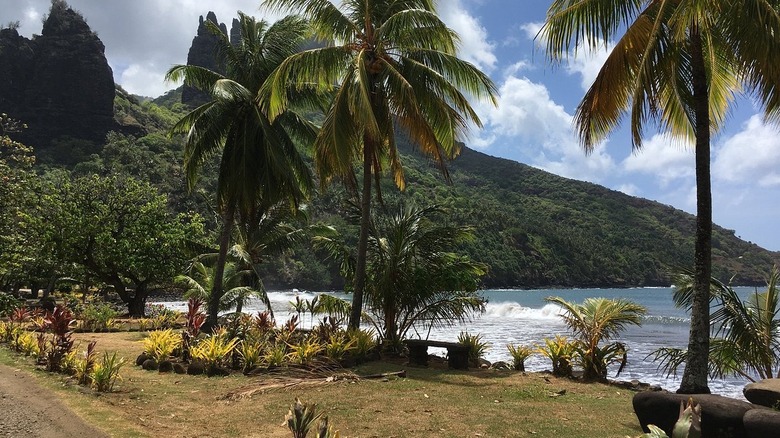
Management / Tripadvisor
While it might not be as impressive as the Cathedral of Notre Dame in Paris, at least prior to the devastating fire in 2019, this island in French Polynesia has its own Notre Dame Cathedral, and visiting it is a fun thing to brag about. Nuku Hiva is the largest of the Marquesas, one of the island groupings of French Polynesia, and it is, like many of the others in Polynesia, achingly beautiful, with jagged contours, sheer cliffs, beaches to make the heart melt, and dense wilds of the forest.
It’s an easy place to connect with inhabitants, not least at local markets where vendors sell fresh fruits, preserves, crafts, and jewelry made from shells and bones. Walkers will enjoy the hikes in the island’s vertiginous interior, along ridges, or to waterfalls, while some treks wind down to beaches and bays. A stop at the cathedral is essential, a structure that symbolizes the island grouping since stone from every one of the six Marquesas islands was used to build it.
Rapa Nui
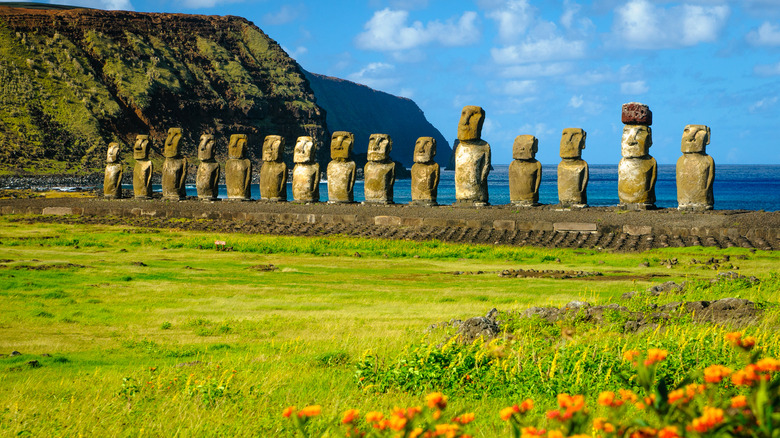
Kristopher Kettner/Shutterstock
Also known as Easter Island, Rapa Nui sits thousands of miles off the coast of Chile, even though it’s part of that country. It’s a remote place, moored in the ocean some distance from any other landmass, and that helps it maintain a shroud of mystery, as do the giant stone statues dotted around the isle. These moai, as they are known, number more than 1,000 and appear near beaches, on the sides of hills, in rows and groups, and ceremonial areas.
Some are mammoth, more than 30 feet in height, and weighing in excess of 70 tons, and most are made from hardened volcanic ash. Beyond being vessels of artistic expression, they are freighted with great cultural significance, a way to commemorate an important member of the tribe or community after they died. Beneath them, the platforms known as “ahu” are the tombs of the individuals they honor. These “moai” are the island’s claim to fame, but visitors can also come here to enjoy fine beaches, peaceful boat rides, and horseback rides along the hilly terrain.
Rarotonga
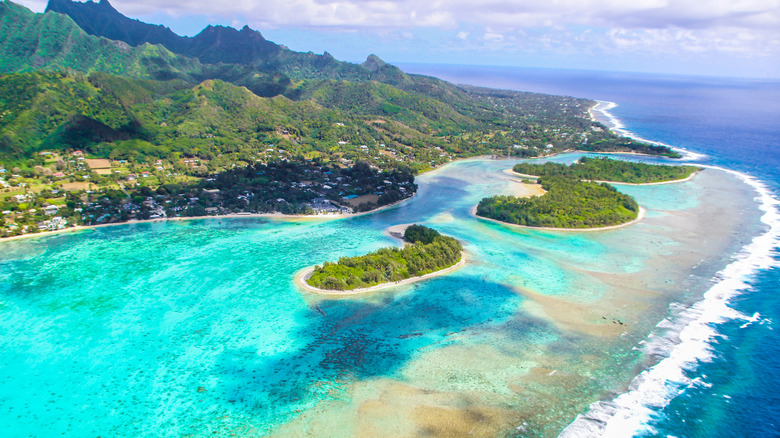
Svetype26/Shutterstock
The main hub of the Cook Islands has a sleepy ambiance, with no traffic lights, no buildings anywhere on the isle higher than a coconut tree, and an easy, low-key way of life that is irresistible. As seems to be a standard for islands in Polynesia, the water here is as glorious as one would expect — clear, turquoise, calm, warm, and always inviting. It teems with fish and other marine creatures, making it a joy to snorkel and dive.
The island is green, filled with tropical flowers (frangipanis are everywhere), and its center rises dramatically to a series of forested volcanic peaks. For sure, hiking is a fine way to explore the interior. Many options present themselves to visitors, from snorkel and dive excursions to trips aboard a fishing charter. Visitors can also stop by a cultural village to learn about local traditions or have a progressive dinner hosted by Cook Islander families.
Samoa
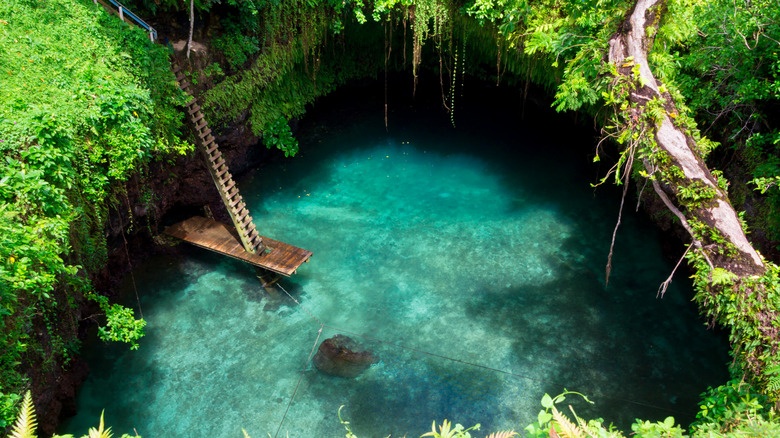
NiarKrad/Shutterstock
Not to be confused with the U.S. territory of American Samoa, which sits to the southeast, the islands of Samoa are an independent nation, easily reached from New Zealand, and promise adventure and relaxation. For travelers searching for a place to decompress, Samoa has many sparkling beaches, where soft sand cedes to warm, clear seas, with coral reefs just offshore. Among the best are Matareva Beach and Falealupo Beach, while near the Samoan capital of Apia, there is a marine reserve where schools of fish swim with abandon.
For something a little unusual, wander around villages destroyed by a volcanic eruption; you’ll see old buildings almost frozen in time within the hardened rock of the lava flow. For a photo-op that will defy belief — is it real or created by AI? — travelers should head to the To-Sua Ocean Trench, a swimming hole with impossibly gorgeous turquoise water that is surrounded by cliffs. While it might seem a little touristy, the eye-popping dance shows during a fiafia night culminate in synchronized performers dancing with fire.
Taha’a
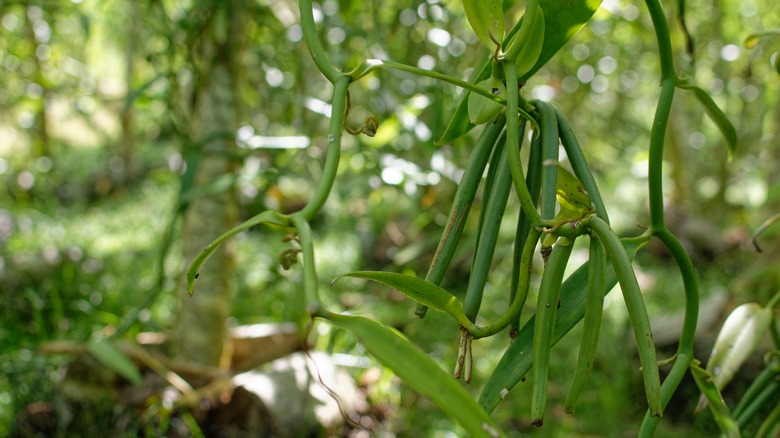
bru greg/Shutterstock
Shaped like a delicate flower, or, to some, appearing similar to a head of broccoli, the French Polynesian island Taha’a sits a little southeast of Bora Bora, but the former offers a much quieter experience than the latter. Swimming, snorkeling, hiking, diving, fishing, and boat trips are typical excursions for visitors, much like elsewhere in Polynesia, but they aren’t the only options. Vanilla farms are sprinkled around Taha’a, and the vanilla island is an unofficial nickname for the destination.
Travelers can visit a plantation, learn about the arduous processes required to grow and harvest vanilla beans, and even purchase some pods directly from the source. For more insider shopping, drop by a pearl farm, where a tour explains how cultured pearls are grown and where visitors can buy pearls at reasonable prices. Taha’s also has two rum distilleries that produce the fiery tipple — Pari Pari distillery and Mana’o distillery, located close to each other — with a tasting session often following a tour.
Tahiti
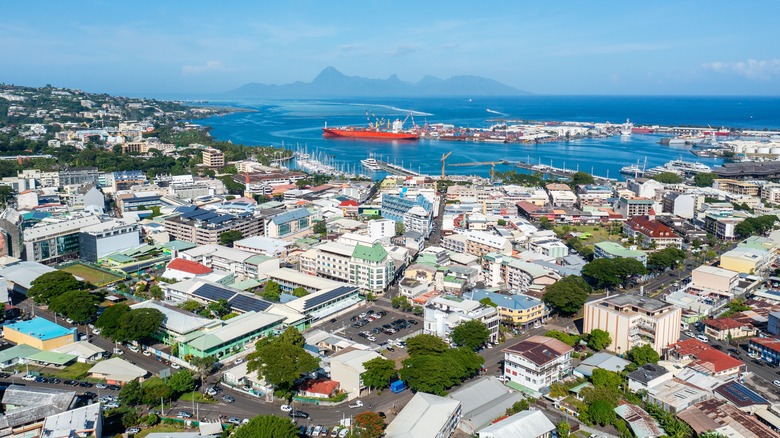
Fernand-P/Shutterstock
This island effortlessly paints the picture of a tropical idyll, one reason, perhaps, that persuaded Post-Impressionist Master Paul Gauguin to spend time here. It’s the hub of French Polynesia, shaped a little like a fat-handled frying pan, home to the capital Papeete, and dominated by the central peak of Mount ‘Orehena. It offers all the fabulous outdoor adventures and delights of other regional destinations, but Tahiti adds a little touch of urban finesse into the mix.
Here, the museums and theaters supply something a little je ne sais quoi to the de rigueur beaches, sea, snorkeling, and sun in abundant supply across Polynesia. Even food trucks on the island, known as roulottes, serve grilled dishes al fresco. One museum worth seeking out is Te Fare Iamanaha, which offers a deep exploration of the culture and history of Polynesia. For live musical and theatrical performances, Te Fare Tauhiti Nui, also known as La Maison de la Culture, is the place.
Taveuni
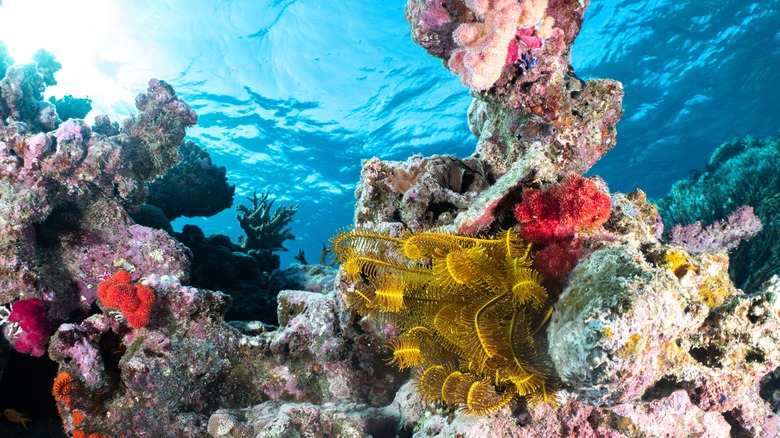
Bobby Vogt/Shutterstock
If Kauai is Hawaii’s garden island, then Taveuni occupies a similar role in Fiji. The greenery here is astounding, especially in Bouma National Heritage Park, which covers one-third of the island through its dense jungle and forests that extend as far as the coast. There is some great hiking here and a number of waterfalls, including one that is an Instagram favorite — Tavoro Falls, possibly the most famous one on the island.
More great hiking is available on the island’s wild southeast, and the Lavena Coastal walk skims along beaches, across rivers, and through sections of jungle. For a more challenging trek, the climb up to Lake Tagimoucia, a crater filled with water, will get the calves burning. For divers, Taveuni is a Holy Grail of sorts, with the Somosomo Strait a bucket-list location. The wall dive in the strait brings divers close to a proliferation of hard and soft coral and the schools of fish that feed on them.
Tongatapu
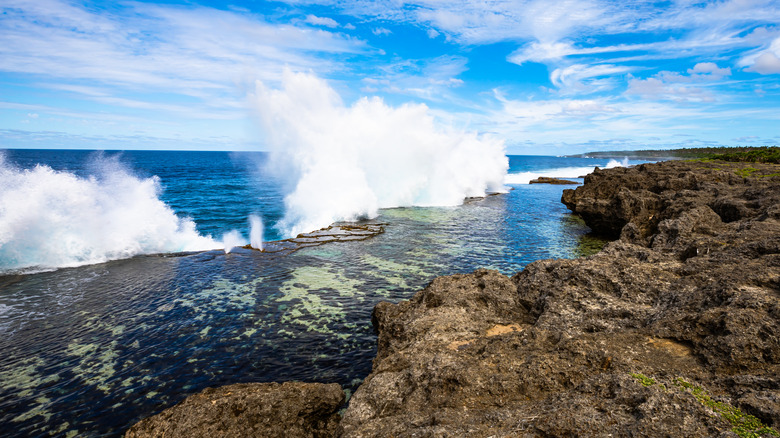
Isaree K Timms/Getty Images
The only island in the Pacific still ruled by a monarchy, Tonga has more than 170 islands in its realm, though the main one, Tongatapu, is where to find the capital, Nuku’alofa. Compared to many other islands on this list, Tongatapu might seem like a bustling spot, with about 105,000 residents on the island, a place of striking scenery and fascinating heritage and culture.
The capital’s harbor speaks to the importance of the city, with ferries and merchant ships lining the wharves, preparing to shuttle people and goods to other islands. The city’s main market, Talamahu, is a visual treat, with vendors hawking fruit, vegetables, fresh fish, and even crafts. More local heritage will be on view at triliths or monuments that date back more than 900 years, at the tombs of former kings, and at burial mounds by the town of Mu’a. For fans of natural phenomena, the island’s blowholes and caves are thrilling excursions.

